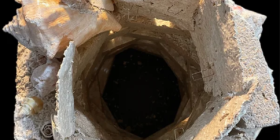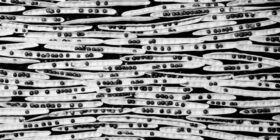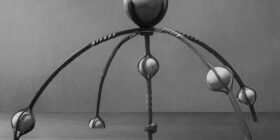Our Once and Future Wetlands: Art, Ecology and Engineering
Lindsay Olson’s artistic practice grows out of an intense curiosity about the ways our society is supported by science and technology. She has worked as Fermi National Accelerator’s first artist in residence, with the CMS experiment at CERN in Switzerland, with the Metropolitan Water Reclamation District of Greater Chicago, the Field Museum, the Chicago Botanic Garden and with the Center for Acoustics Research and Education at the University of New Hampshire.
In 2022/24, she worked as the first artist in residence with The Wetlands Initiative, a scrappy wetland restoration group working in the Midwest,USA.

Calumet art #2
For the last decade I have been partnering with scientists and conservation groups to create art that tells the story of how scientific research supports our society. I use artwork to communicate the elegant necessity and lifesaving work of ecologists and scientists.

Harry and I in the muck (photo: Gary Sullivan)
On my first day working as The Wetland Initiatives artist in residence, I found myself standing in the bright June sunlight in Little Calumet River corridor in the heart of the Midwest rust belt. This is an area of the US that’s been heavily degraded by industry.
Wetland restoration work begins with controlling the hydrology. That means installing water control structures that mimic the natural hydrology of this region. I was helping the crew install water gages that measure the ebb and flow of water in the site.

Indidan Ridge Marsh vistas
That day, I listened to the discussions between Dr. Gary Sullivan, TWI’s senior ecologist, Harry Kuttner, Calumet coordinator and Jim Monchak, Geospatial Analyst. They were discussing last season’s eradication of phragmites (an invasive plant species) and the coming season’s plans for planting seedlings. In the background the drone of the expressway blended with bird calls and buzzing pollinators.
This place was alive with energy and not just the kind pulsating through the Commonwealth Edison pilons above our heads.

Pickerelweed MLK
And at my feet, were the plants rattle snake master, hybrid cattail, hard stem bulrush, and sweet flag to only name a few, all thriving in the space created by the removal of invasives the previous fall. Having nearly fallen in the muck that morning, I also realized I was falling hard for wetland field work in general and this region in particular. TWI’s expansive restoration was already taking root here, in the heart of the rust belt.

Calumet before Indian Ridge Marsh
For a very long time, these severely degraded parcels of land have been on conservation wish lists for restoration. Now, TWI, in partnership with other organizations has already achieved huge gains in healing some of these damaged ecosystems and returning them to welcoming, publicly accessible natural areas that support rare birds and wildlife.

Gary’s Hemi Marsh map
Working alongside the crew that day, I learned about the importance of hemi marsh habitat and how the parcels of land in the region are no longer connected by the original hydrology. TWI works to re-sculpt the land and control hydrology in these isolated parcels of wetlands to mimic natural processes.
When these processes are returned, nature takes over and the wetlands begin to function as they were intended to clean water, support a diverse group of plants, insects, animals, birds and even microbes unique to this region.

Muskrat (photo: Gary Sullivan)
When the right water conditions are restored, Hemi marsh is created primarily by muskrats. They do so by cutting down marsh vegetation in characteristic patterns to create their homes and feeding ‘platforms within the aquatic landscape. They are the hemi marsh architects. Beavers create deeper channels for traveling, sometimes cutting them across but they don’t create the characteristic hemi marsh plant architecture. Muskrats are key partners with TWI in their restoration efforts.

Books and my stitching in process
My studio practice has three phases. The first involves conducting research: both my own visual research and working in the field to understand how wetland restoration works. Then, I translate what I have learned into accessible art and use the project help the others appreciate TWI’s restoration work.

Calumet Region 1
The central theme in this piece is the creation of hemi marsh conditions. The different depths found in Gary’s map are the foundation of the piece. I’ve stitched flora found in a restored hemi marsh: American louts (aspiration at this point) sneezeweed and marsh marigold. The small squares are a stand in for the idea that the remnant wetlands are scattered and disconnected. Untangling ownership of these parcels is complex, requiring patience and persistence.

Juvenile Black-crowned Night-Heron
Even though TWI restoration efforts are in their very early stages in the region, secretive marsh birds like the state-endangered Common Gallinule and Black-crowned Night-Heron, pollinators and other insects, amphibians and fish are beginning to establish themselves in the region again.
With the experiences of field work, book learning and interviews, it was time to return to my studio and begin the process of collecting ideas from the art side of things. Sci art exists on a continuum. At one end is scientific illustration, art in the service of science. At the other end is art inspired by science: art that hints at science. In my practice, I’m aiming for something in the middle. I want my art to be grounded in accurate science but use all of the tools in my artist design kit to draw the viewer in: color, value, line quality, texture, symmetry, and craftsmanship. I want the work to be as beautiful as I can make it. Even if someone is not interested in the science, I want them to enjoy the art on its own. The art can function as a safe introduction to science.

Floral collar from Tutankhamun’s Embalming Cache, ca. 1336–1327 B.C.
Egyptian, New Kingdom
Papyrus, olive leaves, persea leaves, nightshade berries, celery (?), faience, linen dyed red; diam. 47 cm (18 1/2 in); d. 17 cm (6 11/16 in); diam. disk beads 0.5 cm (3/16 in)
The Metropolitan Museum of Art, New York, Gift of Theodore M. Davis, 1909 (09.184.216)
http://www.metmuseum.org/Collections/search-the-collections/544782
Early in my visual research, I found a 3000-year-old floral collar buried with King Tut in the Metropolitan Museum of Art’s collection. I was familiar with ancient Egyptian bejeweled collars on images of kings and queens. What I did not know is that royalty was buried with elaborately fashioned fresh flower collars. We are not the only people in history to use fresh flowers to honor our dead.
I’ve been exploring the design possibilities of a circular format in my work for a long time. These collars seemed a perfect expression of a broken circle: a metaphor for the broken cycles of nature we humans have wrought upon the land and the ways in which we use our understanding of ecology to restore these pieces of remnant wetlands.
The other intriguing connection to the project is that the funeral collars are, in intent at least, a garment intended to be worn by royalty in the afterlife. I used this symbolism to suggest a very personal connection between viewers and wetland restoration.

Calumet Region III
I create art primarily in textiles. All of us use textiles in our everyday lives and can easily relate to them. We use them to create comfortable homes, express ourselves in fashion. The time -consuming processes I use, (embroidery, quilting and beading) are a way to denote luxury and to elevate the subject matter.
It’s unexpected to see elegant art about an industrial landscape and that’s another way to invite viewers to take a closer look. I’ve chosen a sliver framed shadow box to hold the pieces. The presentation has a royal feel. I am honoring the work we are engaged in by making the container look like a treasure chest.
The colors, techniques and elements reflect the challenges faced today and a vision of the future of these wetland jewels- in- the making: a quiet revolution in restoration and land conservation.

Calumet Region III Tribes (detail)
In the lower part of the collar, I have embroidered the names of American Indian tribes to acknowledge that these are the homelands of the Potawatomi and dozens of other Native tribes. Nearly half a million tribe members make their home here in the Upper Midwest region.

Installing gage
Even though the projects in the Calumet Region are in the early stages they are yielding significant change in plant and animal diversity.

Shoreline modificaitons
In September of 2023, the bulldozers rolled in to Indian Ridge Marsh to complete the shoreline modifications in Dr. Sullivan’s plans. This is the engineering part of the project to reestablish a more gradual, sloping transition from the upland habitats down to the deeper-water marsh. Now, conditions are perfect for the muskrats do their work.

Dixon Waterfowl Refuge (photo: Gary Sullivan)
TWI’s crowning achievement is the work they have accomplished over decades in the Dixon Waterfowl Refuge. After more than a century of industrial agriculture the Refuge has been transformed and is bursting with migrating and resident waterfowl, ever increasing diversity of plants, insects, and the occasional fisherman.
The decades long restoration work at the Dixon Waterfowl Refuge is the proof of concept and offers a good idea of what the work throughout the Calumet region will look like in the future.

Vera Leopold
One of my favorite days in the field was participating in a pollinator blitz in the summer of 2022. The data we collected that day on the butterflies, moths, bees, wasps, beetles, and more that are making use of the Refuge habitats is used to measure ecosystem quality as the project moves forward.

Painted Lady (photo: Vera Leopold)
That day sharp-eyed staff member Vera Leopold sighted a Ruby Throated humming bird, one of a few avian pollinators.

Midewin National Tallgrass Prairie (photo: Gary Sullivan)
Some might wonder why a wetland restoration group is working at Midewin National Tallgrass Prairie – https://www.fs.usda.gov/midewin?ref=travellens.co The short answer is that water always seeks its level whether its running down a mountain or flowing towards a gentle depression in the prairie. In partnership with the US Forest Service, TWI is working on a massive scale. Habitats within the Tallgrass Prairie, like a Marsh are part of a mosaic of interdependent habitats: Sedge Meadows, Oak Savanna, Mesic Prairie and Wet Prairie. This project highlights the idea that wetlands belong everywhere.

Midewin crew
Over a couple of days last year, I visited to site to learn about seed collection and seed sorting. As we sorted seeds in the processing room, every time we opened a different bag, a unique vegetive smell filled the workspace. When out in the field I just smelled “prairie” but in each of these bags, I smelled bluestem, swamp milkweed, false boneset, beard tongue and dropseed. I wanted to capture some of this experience in this artwork.

Midewin Tallgrass Prairie
In this piece I’ve included just a few of these restored habitats that knit together the wider ecosystem at this site. In the center, I’ve featured the Dolomite Prairie. It is a rare habitat and favors a unique blend of plants.
This site was once a US Army arsenal and I included a suggestion of the huge concrete bunkers that used to dominate the site.

Midewin bunker
These rugged bunkers were built to contain possible explosions of the munitions stored in them. Removing many of those fortified structures has been a huge job carried out by other Midewin partners.

Smart wetland (drone photo: Mike Richolson)
Across Illinois, TWI and their partners are demonstrating how small on-farm wetlands provide a solution to nutrient runoff while reducing costs over time for farmers. Dr. Jill Kostel, Senior Environmental Engineer and her team work with farmers designing Smart Wetlands. Because each farm is situated on a unique parcel of land, each project is specially sited to be on an unproductive area that also connects with local hydrology.
When I visited several of these hardworking wetlands, I noticed that the plant diversity was very different at the beginning of the system than on the back end. Water flowing into the system carried excess nitrogen and phosphorus running off the field that few plants can tolerate. As the water flows through the system and excess nutrients are taken up by wetland microbes and plants. The back end of the system is rich in a huge diversity of plants reflecting the lowered nutrient load. Meant to mimic the cleansing power of natural wetlands, Smart Wetlands offer an elegant and useful solution for the use of marginal ground on a field. Farmers appreciate the soil conservation and water quality improvements on their land too.

Smart Wetland

Dixon Waterfowl Refuge
At a time when we are challenged by the harsh realities of climate change, the work of TWI offers us a way forward using engineering prowess, a deep understanding of ecology and a willingness to partner with like-minded communities and conservation groups. What we are witnessing is the creation of functional wetlands created from formerly degraded landscapes. This work has personal significance and deep meaning to every member of the TWI team. I can’t wait to see how these skillful and hopeful projects develop in the coming years. This project is a celebration of their success and the artwork that helps to tell the story of wetland restoration.

Canoe launch Dixon
……………………………………..
https://www.lindsayolsonart.com
https://www.wetlands-initiative.org/
https://www.instagram.com/lindsayolson816/
All images copyright and courtesy of Lindsay Olson
Get the Full Experience
Read the rest of this article, and view all articles in full from just £10 for 3 months.



No comments yet.